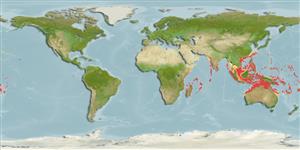Environment: milieu / climate zone / depth range / distribution range
ນິເວດວິທະຍາ
ສັດທະເລ ກ່ຽວກັນຫີນ; ລະດັບຄວາມເລິກ 4 - 200 m (Ref. 5222), usually 12 - 90 m (Ref. 37816). Tropical; 29°N - 26°S, 38°E - 171°W (Ref. 5222)
Indo-Pacific: east coast of Africa (Zanzibar and Mafia Island, Tanzania) to Samoa, north to Ryukyu Islands, south to Queensland, Australia.
Length at first maturity / ຂະໜາດ / ນ້ຳໜັກ / Age
Maturity: Lm ?, range 67 - ? cm
Max length : 65.0 cm TL ຕົວຜູ້/ບໍ່ມີເພດ; (Ref. 48635)
ຄີ (ໜາມ)ແຂງຢູ່ຫຼັງປາ (ທັງໝົດ): 9; ຄີຫຼັງຂອງປາ (ຄີອ່ອນ) (ທັງໝົດ): 14; ຄີ(ໜາມ) ແຂງຢູ່ຄີກົ້ນປາ
ກຸ່ມປາກະດູກແຂງ
ຄວາມຖີ່ຂອງກຸ່ມຖ່າຍທອດພັນ
ປາທີ່ມີການເຄື່ອນຍ້າຍຈາກທະເລໄປຫານ້ຳຈືດ ແລະນ້ຳຈືດຫາທະເລ
ປາທີ່ມີການເຄື່ອນຍ້າຍຈາກທະເລແລະໄປໄຂ່ຢູ່ນ້ຳຈືດ
ຄີກົ້ນຂອງປາ
ສັດທີ່ມີກະດູກສັນຫັຼງ
ການຖ່າຍທອດທາງກຳມະພັນຈາກພໍ່ແມ່ຫາລູກ 3; ຄີກົ້ນຂອງປາ: 8. This species is distinguished by the following characters: body oblong, its depth 2.8-3.5 in SL; preopercle rounded, finely serrate, the lower edge fleshy; opercle with 3 flat spines; upper edge of operculum almost straight; rear nostrils not much bigger than anterior nostrils; front of jaws with a pair of large canine teeth; 1-3 large canines at midside of lower jaw; gill rakers of first gill arch 7-9 + 13-16 = 20-25 (including 4 to 7 rudiments on each limb); caudal fin lunate, the upper and lower lobes produced, about twice length of middle rays; pectoral-fin rays 17-19; lateral-line scales 66-76, in series 109-127. Colour of head, body and fins generally reddish with small irregular pale blue to pink spots; 3-4 diffuse pale saddle on back; broad caudal fin usually dusky, with narrow white posterior margin or edge (yellow in V. louti); juveniles similar in colour to adults, but with relatively fewer and larger pale blue or pink spots (Ref. 39231, 89707, 90102).
A generally uncommon species that inhabits seaward reefs (Ref. 9710). Juveniles inshore on algae and soft coral reefs, usually swimming well above the substrate, looking much like a basslet (Ref. 48635). Solitary (Ref 90102) or found in small groups (Ref. 11888). Feeds on fishes. Of little interest to fisheries, because of its small size and rarity, but flesh is excellent.
Caught with handline, traps, and spear (Ref. 39231).
Life cycle and mating behavior
ການຈະເລີນເຕັມໄວ | ການສືບພັນ | ການວາງໄຂ່ | ໄຂ່ | ຄວາມດົກຂອງໄຂ່ປາ | ຕົວອ່ອນ
Heemstra, P.C. and J.E. Randall, 1993. FAO Species Catalogue. Vol. 16. Groupers of the world (family Serranidae, subfamily Epinephelinae). An annotated and illustrated catalogue of the grouper, rockcod, hind, coral grouper and lyretail species known to date. Rome: FAO. FAO Fish. Synop. 125(16):382 p. (Ref. 5222)
IUCN Red List Status (Ref. 130435)
Threat to humans
Harmless
Human uses
ການປະມົງ: ການປະມົງແບບກຸ້ມຕົນເອງ
ຂໍ້ມູນຕື່ມອີກ
ຊື່ສາມັນຄຳສັບຄ້າຍຄືກັນການເຜົາໃໝ້ພະລັງງານໂດຍປ່ຽນທາດອາຫານໃນຮ່າງກາຍໃຫ້ກາຍເປັນຊີ້ນແລະໜັງຜູ້ລ້າການສຶກສາຜົນກະທົບຂອງສານຜິດທີ່ມີຜົນກະທົບຕໍ່ລະບົບນິເວດການສືບພັນການຈະເລີນເຕັມໄວການວາງໄຂ່ການສັງລວມການວາງໄຂ່ຄວາມດົກຂອງໄຂ່ປາໄຂ່Egg development
ເອກະສານອ້າງອີງການລ້ຽງສັດນ້ຳຂໍ້ມູນການລ້ຽງສັດນ້ຳສາຍພັນກຳມະພັນElectrophoresesການຖ່າຍທອດທາງກຳມະພັນຈາກພໍ່ແມ່ຫາລູກພະຍາດການປຸງແຕ່ງNutrientsMass conversion
ຜູ້ຮ່ວມມືຮູບStamps, Coins Misc.ສຽງຫອຍມີພິດຊະນິດນຶ່ງທີ່ອາໄສໃນທະເລຄວາມໄວປະເພດການລອຍເນື້ອທີ່ເຫືອກOtolithsສະໝອງວິໄສທັດ
ເຄື່ອງມື
Special reports
Download XML
ແຫຼ່ງອີນເຕີເນັດ
Estimates based on models
Preferred temperature (Ref.
123201): 23.9 - 28.9, mean 27.7 °C (based on 1802 cells).
Phylogenetic diversity index (Ref.
82804): PD
50 = 0.7500 [Uniqueness, from 0.5 = low to 2.0 = high].
Bayesian length-weight: a=0.01349 (0.00851 - 0.02138), b=3.07 (2.94 - 3.20), in cm total length, based on LWR estimates for this species & (Sub)family-body (Ref.
93245).
ຊັ້ນເຂດຮ້ອນ (Ref.
69278): 4.5 ±0.80 se; based on food items.
ຄວາມຢືດຢຸ່ນ (Ref.
120179): ຂະໜາດກາງ, ປະຊາກອນຕຳ່ສຸດທີ່ໃຊ້ເວລາສອງເທົ່າ 1.4 - 4.4 ປີ (Preliminary K or Fecundity.).
Fishing Vulnerability (Ref.
59153): Moderate to high vulnerability (46 of 100).
Nutrients (Ref.
124155): Calcium = 34.1 [19.7, 61.7] mg/100g; Iron = 0.611 [0.316, 1.027] mg/100g; Protein = 18.9 [17.0, 20.6] %; Omega3 = 0.177 [0.114, 0.284] g/100g; Selenium = 49.3 [28.0, 93.9] μg/100g; VitaminA = 83.1 [29.8, 278.9] μg/100g; Zinc = 0.708 [0.473, 1.044] mg/100g (wet weight);
